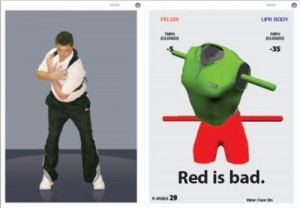3D Golf Analysis
I felt compelled to write this article as I have seen a growing trend in junior golfers coming to see me after having had a 3D or K-vest assessment.
Whilst these tools are great for getting a basic understanding of movement patterns, plane, sequencing and speeds related to the golf swing they cannot be used as a diagnosis tool for potential or current injuries.
Most of these systems utilise sensors placed in a vest or straps that then provide a computerised 3D representation of the data. These sensors are not an accurate representation of what the body is actually doing.

The spine is made up of the pelvis, skull, 24 separate vertebrae and ribs, this cannot be depicted as simply a pelvis and trunk and give an accurate reading of what is going on.
It does give a snapshot of how the body is moving, but giving golfers images showing huge discrepancies between their trunk and pelvis implies that the lower back is going through extreme or excessive motion and could be causing back problems. This can be very frightening for junior golfers and their parents.
I have had many golfers and parents of golfers coming to me with computer images of how bad their back position is, and a concern about how many problems they are going to have with their back in the future, what types of pain or related problems they may cause if they continue.
A lot of this seems to be due to miscommunication between the golf professionals the players and their parents, sometimes they have only heard certain parts of the information or they have interpreted it incorrectly.
Back pain is a very worrying topic for many people. As soon as parents in particular hear words like Torque, stress, excessive movement, hyperextension, injury, coming from a golf professional they tend to panic and many I know have withdrawn their children for playing golf and other sports (temporarily)!
At the present time, in the world of medicine, we have no way of predicting injury with any certainty. Thousands of studies have been carried out using 3D MRI, movement analysis software, screening and no one has come up with a good predictor of injury.
Personally after working in healthcare for over 10 years, I cannot predict any injuries. I can get a good idea of how someone moves, flexibility, strength, power, weaknesses, stability, BUT I cannot say that they will have an injury, as I just don’t know and the information is not out there at the current time.
This does not mean everyone needs to go and see a Physio, Osteopath, Chiropractor or Doctor if something comes up on his or her assessment. The human body is amazingly adaptable and in the vast majority of cases can be trained to move in a different way, but we need to be mindful of the language we use and how we convey it.
My take home message would be that 3D assessment is very useful, but the interpretation and the language used to convey this data, needs to be thought through very carefully first.
Kind Regards
Mark Leyland MCSP BScH FAFS
Sports Physiotherapist


